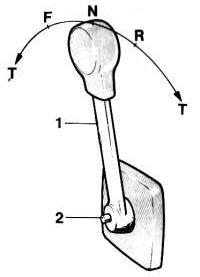
1 minute read
Presentation
INSTRUMENT PANEL
CONTROL SYSTEM

1. Switch, optional equipment 2. Warning lamp, “Excess temp.” 3. Place for instrument (ø 52 mm opt. equipment) 4. Warning lamp, “No oil pressure” 5. Switch, optional equipment 6. Warning lamp, “No battery charging” 7. Siren, “No oil pressure, excess temp.” 8. Key switch
Volvo Penta Single Control System For side mounting
1. Control lever 2. Disengaging button Push in the button when the control lever is in neutral and move the lever a bit forwards. Release button. The lever is now used only for engine speed control. To use the lever for both engine speed control and gear-changing, push in the button and pull back the lever to neutral.
N= Neutral F = Control lever in position for running “Forward” R = Control lever in position for running “Reverse” T = Engine speed control
Important information on the function of your engine:
FUEL
Use diesel fuel oil of quality “Autodiesel”. Poorer fuel quality can cause interruptions in operation.
LUBRICATING OIL
Use only oil with quality CD (DS) according to the API system. Volvo Penta oil for diesel engines can be used with advantage since it meets these quality demands. See under “Technical Data” concerning the viscosity.
RUNNING-IN A new marine engine must be run-in with due care during the first 20 hours of operation. If full output is taken out during this time, it should only be done for short periods. Oil change. Change the engine lubricating oil and the oil filter after the engine has been run for 20 hours. See further under “Checks and Service”.
ENGINE SPEED Max. speed: 41.7 rev/sec (2500 rev/mm). For choice of correct propeller, refer to the Volvo Penta propeller diagram. Check the engine speed with normal load in the boat. In order to utilize the maximum performance of the engine, an engine speed as high as possible should be chosen but not, however, greater than 41.7 rev/sec (2500 rev/mm). NOTE. When the boat has been in the water for some time, the speed and max. rev/mm can drop due to marine growth on the hull. Prevent marine growth by painting the bottom of the boat with anti-fouling paint. See under “Measures taken when launching”.







